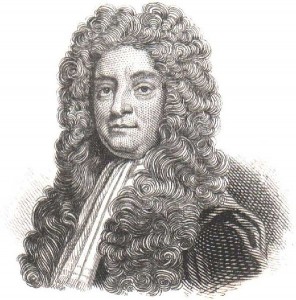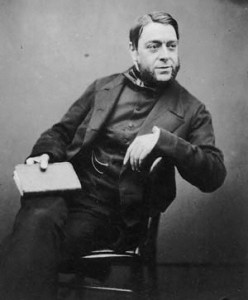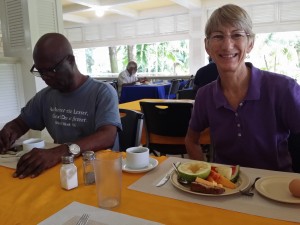
Bird Notes, Part 1: Jamaica
April 12th, 2018
As some people may know, I am rather addicted to birds – of the wild variety, that is. I am a member of BirdLife Jamaica, the local branch of a global entity called BirdLife International. It changed its name from Gosse Bird Club in 1998.

Hans Sloane, a bigwig and a collector. (The wig must have been awfully hot in Jamaica…?) Image: National Gallery of Jamaica
The history of ornithology (that is, the study of birds) in Jamaica goes back to the late 17th century, when an Irishman named Hans Sloane arrived on the island to serve as physician to the Governor – and started “collecting.” He was wealthy, with a very substantial wig. He was, in fact, literally a “bigwig”: he became even wealthier after marrying the heiress to a Jamaican sugar plantation. He collected many thousands of objects during his travels – books, dried plants, manuscripts, coins and medals. Some of these collections eventually went to Britain’s Natural History Museum; the original collections, which he bequeathed to the nation in his will, got the British Museum started. You will of course understand this Museum is far from British; it consists primarily of objects that the British carried (or stole) from somewhere else. It’s a sort of “finder’s keepers” museum, although to be fair some of the objects have been returned to their owners.

Philip Henry Gosse had a great passion for marine life back in England. He did beautiful colour plates, like this one. (Photo: Biodiversity Heritage Library)
Moving on a little bit, we come to Philip Henry Gosse, who seems a more likeable fellow altogether, and a genuine naturalist (I’m not sure that expression is used much any more). He was not a bigwig, but a rather impecunious clerk in Newfoundland. He tried farming in Canada, and published a book called The Canadian Naturalist. He moved to Pennsylvania, then Alabama, where he was a teacher for a while. Then back to England…and finally off to Jamaica (a sea journey of eight weeks or so) in 1844. He was rather a restless man, it seems, who never made much money at all. However, he loved living in Jamaica, where he went to collect insects and birds. He was apparently entranced by the island’s beauty. He spent 18 months in Bluefields, Westmoreland. No wonder he got hooked.

Philip Henry Gosse, 1855. (Image: By Maull & Polybank – Oxford Dictionary of National Biography, Public Domain)
Mr. Gosse listed around 200 bird species in Jamaica at the time, and he wrote and illustrated the first books on Jamaican birds: Birds of Jamaica, Illustrations of the Birds of Jamaica (colour plates, published separately) and A Naturalist’s Sojourn in Jamaica. The latter work was praised by none other than Charles Darwin; but as a deeply religious man, Gosse was rather conflicted about evolutionary theories. He was considered an excellent writer, and quite prolific. His works on his return to England in 1846 were quite popular. His was a fascinating life, described here if you want to read more about him.
So, the Gosse Bird Club came into being in 1963. Frankly, I prefer that name to BirdLife. Anyway, we modern-day bird people went off on our annual weekend trip to Portland recently. BirdLife Jamaica is a motley crew of all ages and walks of life. Our passion for birds binds us together. We are wedded to our binoculars, and some of us have fancy cameras, too. Perched on a windswept cliff, we scoured the horizon for White-tailed Tropicbirds. We wandered on the marvellously lush roads of San San, fluttering with bird life; and the paths of Frenchman’s Cove, where herons sometimes pose for their picture. We walked up Ecclesdown Road, with its rolling views of forested hills – noting sadly that trees had been carelessly felled on each side of the road. I do dislike chain saws and cutlasses.
Birding is really quite addictive. It is, in many ways, a leisurely pursuit; you can’t do it in a rush. However, at times it can become suddenly intense, when an interesting species is spotted. Then we freeze and quieten down, quivering slightly, binoculars raised. We speak in hushed whispers: “You see that tall tree? Well, it’s on the little bush just in front, flitting around…You see? You can’t see it? I’m sure it’s a Worm-eating Warbler. Oh no…It’s flown off.” Further down the road, another small group will turn, and wonder what we saw.
And then we move on, having obtained a glimpse – or maybe not – of something lovely. I wish Mr. Gosse had been with us in Portland.
Or perhaps he was.
Tags: birding, BirdLife Jamaica, birds, Bluefields, British Museum, Canada, Charles Darwin, education, Hans Sloane, Jamaica, NGO, Philip Henry Gosse, Portland, San San
The Gleaner reserves the right not to publish comments that may be deemed libelous, derogatory or indecent.
To respond to The Gleaner please use the feedback form.
- We Are the Zoomers
- Living Online with Humans and Birds: NAOC 2020
- Human Trafficking and the Problem of Public Education
- Down Memory Lane
- Are We Ready to Recover from COVID-19?
- Road Safety Matters: Is Your Vehicle Safe?
- Sexual Harassment, Me Too, and the Minister’s Disturbing Giggle
- The Vulnerable Senior Citizens, Private Care Homes and COVID-19
- A Muddle Over Masks
- Here is Something Life-Saving You Can Do: Give Blood!



